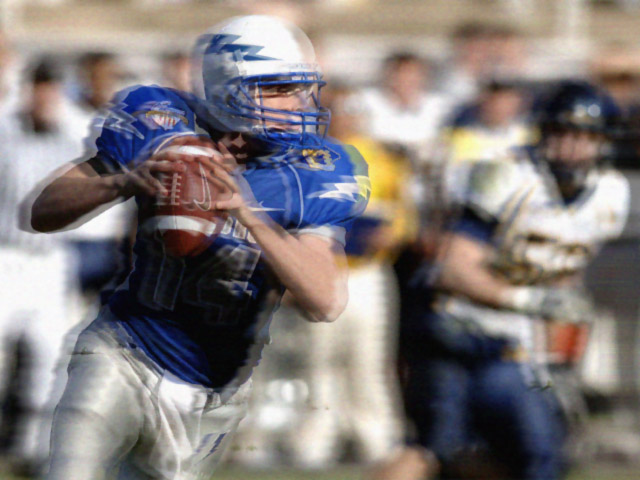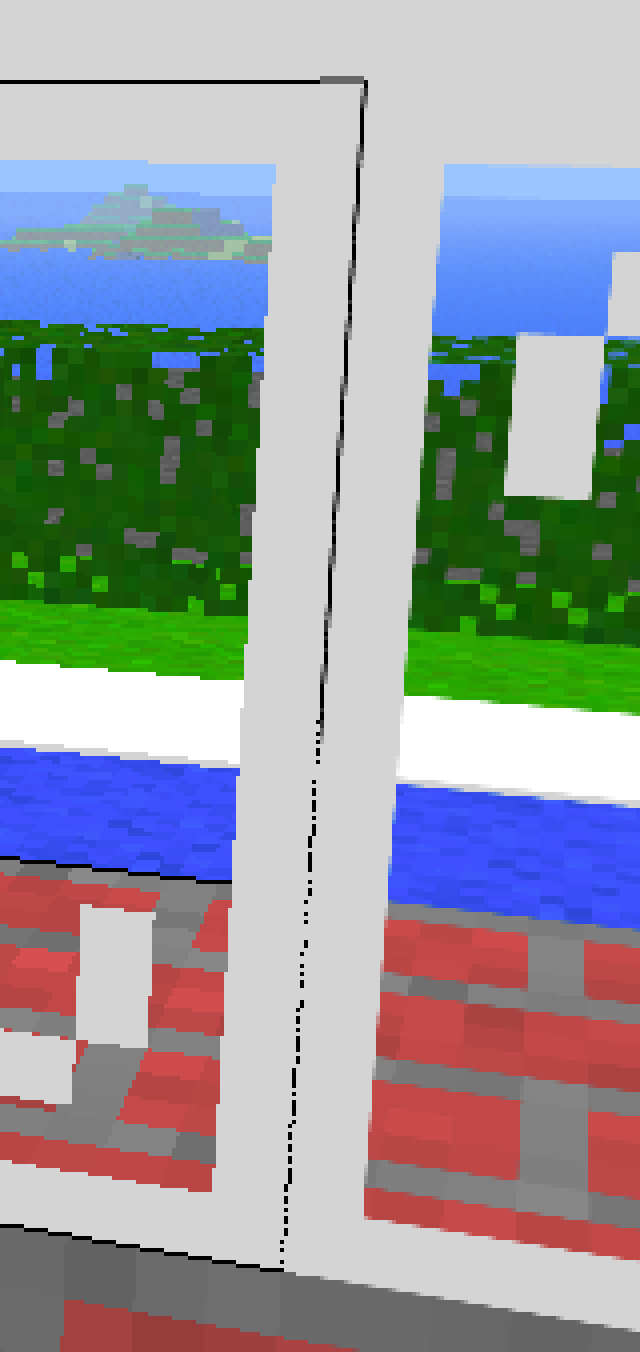|
Temporal Anti-aliasing
Temporal anti-aliasing (TAA), also known as TXAA (a proprietary technology) or TMAA/TSSAA (''Temporal Super-Sampling Anti-Aliasing''), is a spatial anti-aliasing technique for computer-generated video that combines information from past frames and the current frame to remove jaggies in the current frame. In TAA, each pixel is sampled once per frame but in each frame the sample is at a different location within the frame. Pixels sampled in past frames are blended with pixels sampled in the current frame to produce an anti-aliased image. Although this method makes TAA achieve a result comparable to supersampling, the technique inevitably causes Ghosting (television), ghosting and blurriness to the image. TAA compared to MSAA Prior to the development of TAA, Multisample anti-aliasing, MSAA was the dominant anti-aliasing technique. MSAA samples (renders) only the edges of polygons, then averages the samples to produce the final pixel value, making it surprisingly efficient in GPU-bound ... [...More Info...] [...Related Items...] OR: [Wikipedia] [Google] [Baidu] |
Spatial Anti-aliasing
In digital signal processing, spatial anti-aliasing is a technique for minimizing the distortion artifacts (aliasing) when representing a high-resolution image at a lower resolution. Anti-aliasing is used in digital photography, computer graphics, digital audio, and many other applications. Anti-aliasing means removing signal components that have a higher frequency than is able to be properly resolved by the recording (or sampling) device. This removal is done before (re)sampling at a lower resolution. When sampling is performed without removing this part of the signal, it causes undesirable artifacts such as black-and-white noise. In signal acquisition and audio, anti-aliasing is often done using an analog anti-aliasing filter to remove the out-of-band component of the input signal prior to sampling with an analog-to-digital converter. In digital photography, optical anti-aliasing filters made of birefringent materials smooth the signal in the spatial optical domain. The anti-a ... [...More Info...] [...Related Items...] OR: [Wikipedia] [Google] [Baidu] |
Jaggies
Jaggies are artifacts in raster images, most frequently from aliasing, which in turn is often caused by non-linear mixing effects producing high-frequency components, or missing or poor anti-aliasing filtering prior to sampling. Jaggies are stair-like lines that appear where there should be "smooth" straight lines or curves. For example, when a nominally straight, un-aliased line steps across one pixel either horizontally or vertically, a "dogleg" occurs halfway through the line, where it crosses the threshold from one pixel to the other. Jaggies should not be confused with most compression artifacts, which are a different phenomenon. Causes Jaggies occur due to the "staircase effect". This is because a line represented in raster mode is approximated by a sequence of pixels. Jaggies can occur for a variety of reasons, the most common being that the output device ( display monitor or printer) does not have sufficient resolution to portray a smooth line. In addition, jaggies o ... [...More Info...] [...Related Items...] OR: [Wikipedia] [Google] [Baidu] |
Supersampling
Supersampling or supersampling anti-aliasing (SSAA) is a spatial anti-aliasing method, i.e. a method used to remove aliasing (jagged and pixelated edges, colloquially known as "jaggies") from images rendered in computer games or other computer programs that generate imagery. Aliasing occurs because unlike real-world objects, which have continuous smooth curves and lines, a computer screen shows the viewer a large number of small squares. These pixels all have the same size, and each one has a single color. A line can only be shown as a collection of pixels, and therefore appears jagged unless it is perfectly horizontal or vertical. The aim of supersampling is to reduce this effect. Color samples are taken at several instances inside the pixel (not just at the center as normal), and an average color value is calculated. This is achieved by rendering the image at a much higher resolution than the one being displayed, then shrinking it to the desired size, using the extra pixels ... [...More Info...] [...Related Items...] OR: [Wikipedia] [Google] [Baidu] |
Ghosting (television)
In television, a ghost is a replica of the transmitted image, offset in position, that is superimposed on top of the main image. It is often caused when a TV signal travels by two different paths to a receiving antenna, with a slight difference in timing.Jorma Hyypia, ''Beating TV Interference'', '' Popular Mechanics'' , June 1980 page 126 Analog ghosting Common causes of ghosts (in the more specific sense) are: * Mismatched impedance along the communication channel, which causes unwanted reflections. The technical term for this phenomenon is ringing. * Multipath distortion, because radio frequency waves may take paths of different length (by reflecting from buildings, transmission lines, aircraft, clouds, etc.) to reach the receiver. In addition, RF leaks may allow a signal to enter the set by a different path; this is most common in a large building such as a tower block or hotel where one TV antenna feeds many different rooms, each fitted with a TV aerial socket ( ... [...More Info...] [...Related Items...] OR: [Wikipedia] [Google] [Baidu] |
Multisample Anti-aliasing
Multisample anti-aliasing (MSAA) is a type of spatial anti-aliasing, a technique used in computer graphics to remove jaggies. It is an optimization of supersampling, where only the necessary parts are sampled more. Jaggies are only noticed in a small area, so the area is quickly found, and only that is anti-aliased. Definition The term generally refers to a special case of supersampling. Initial implementations of full-scene anti-aliasing ( FSAA) worked conceptually by simply rendering a scene at a higher resolution, and then downsampling to a lower-resolution output. Most modern GPUs are capable of this form of anti-aliasing, but it greatly taxes resources such as texture, bandwidth, and fillrate. (If a program is highly TCL-bound or CPU-bound, supersampling can be used without much performance hit.) According to the OpenGL OpenGL (Open Graphics Library) is a Language-independent specification, cross-language, cross-platform application programming interface (API) ... [...More Info...] [...Related Items...] OR: [Wikipedia] [Google] [Baidu] |
Fast Approximate Anti-aliasing
Fast approximate anti-aliasing (FXAA) is a screen-space anti-aliasing algorithm created by Timothy Lottes at Nvidia. FXAA 3 is released under a public domain license. A later version, FXAA 3.11, is released under a 3-clause BSD license. Algorithm description # The input data is the rendered image and optionally the luminance data. # Acquire the luminance data. This data could be passed into the FXAA algorithm from the rendering step as an alpha channel embedded into the image to be antialiased, calculated from the rendered image, or approximated by using the green channel as the luminance data. # Find high contrast pixels by using a high pass filter that uses the luminance data. Low contrast pixels that are found are excluded from being further altered by FXAA. The high pass filter that excludes low contrast pixels can be tuned to balance speed and sensitivity. # Use contrast between adjacent pixels to heuristically find edges, and determine whether the edges are in the horizon ... [...More Info...] [...Related Items...] OR: [Wikipedia] [Google] [Baidu] |
Motion Compensation
Motion compensation in computing is an algorithmic technique used to predict a frame in a video given the previous and/or future frames by accounting for motion of the camera and/or objects in the video. It is employed in the encoding of video data for video compression, for example in the generation of files. Motion compensation describes a picture in terms of the transformation of a reference picture to the current picture. The reference picture may be previous in time or even from the future. When images can be accurately synthesized from previously transmitted/stored images, the compression efficiency can be improved. Motion compensation is one of the two key video compression techniques used in video coding standards, along with the discrete cosine transform (DCT). Most video coding standards, such as the H.26x and MPEG formats, typically use motion-compensated DCT hybrid coding, known as block motion compensation (BMC) or motion-compensated DCT (MC DCT). Functionality ... [...More Info...] [...Related Items...] OR: [Wikipedia] [Google] [Baidu] |
Nvidia
Nvidia Corporation ( ) is an American multinational corporation and technology company headquartered in Santa Clara, California, and incorporated in Delaware. Founded in 1993 by Jensen Huang (president and CEO), Chris Malachowsky, and Curtis Priem, it designs and supplies graphics processing units (GPUs), application programming interfaces (APIs) for data science and high-performance computing, and system on a chip units (SoCs) for mobile computing and the automotive market. Nvidia is also a leading supplier of artificial intelligence (AI) hardware and software. Nvidia outsources the manufacturing of the hardware it designs. Nvidia's professional line of GPUs are used for edge-to-cloud computing and in supercomputers and workstations for applications in fields such as architecture, engineering and construction, media and entertainment, automotive, scientific research, and manufacturing design. Its GeForce line of GPUs are aimed at the consumer market and are used in ap ... [...More Info...] [...Related Items...] OR: [Wikipedia] [Google] [Baidu] |
Deep Learning Super Sampling
Deep Learning Super Sampling (DLSS) is a suite of Real-time computing, real-time deep learning image enhancement and Image scaling, upscaling technologies developed by Nvidia that are available in a number of video games. The goal of these technologies is to allow the majority of the graphics pipeline to run at a lower Display resolution, resolution for increased performance, and then infer a higher resolution image from this that approximates the same level of detail as if the image had been rendered at this higher resolution. This allows for higher graphical settings and/or frame rates for a given output resolution, depending on user preference. All generations of DLSS are available on all Nvidia RTX, RTX-branded cards from Nvidia in supported titles. However, the Frame Generation feature is only supported on GeForce 40 series, 40 series GPUs or newer and Multi Frame Generation is only available on GeForce 50 series, 50 series GPUs. History Nvidia advertised DLSS as a key feat ... [...More Info...] [...Related Items...] OR: [Wikipedia] [Google] [Baidu] |
Supersampling
Supersampling or supersampling anti-aliasing (SSAA) is a spatial anti-aliasing method, i.e. a method used to remove aliasing (jagged and pixelated edges, colloquially known as "jaggies") from images rendered in computer games or other computer programs that generate imagery. Aliasing occurs because unlike real-world objects, which have continuous smooth curves and lines, a computer screen shows the viewer a large number of small squares. These pixels all have the same size, and each one has a single color. A line can only be shown as a collection of pixels, and therefore appears jagged unless it is perfectly horizontal or vertical. The aim of supersampling is to reduce this effect. Color samples are taken at several instances inside the pixel (not just at the center as normal), and an average color value is calculated. This is achieved by rendering the image at a much higher resolution than the one being displayed, then shrinking it to the desired size, using the extra pixels ... [...More Info...] [...Related Items...] OR: [Wikipedia] [Google] [Baidu] |
Deinterlacing
Deinterlacing is the process of converting interlaced video into a non-interlaced or Progressive scan, progressive form. Interlaced video signals are commonly found in analog television, VHS, Laserdisc, digital television (HDTV) when in the 1080i format, some DVD titles, and a smaller number of Blu-ray discs. An interlaced video frame consists of two Field (video), fields taken in sequence: the first containing all the odd lines of the image, and the second all the even lines. Analog television employed this technique because it allowed for less transmission bandwidth while keeping a high frame rate for smoother and more life-like motion. A non-interlaced (or progressive scan) signal that uses the same bandwidth only updates the display half as often and was found to create a perceived flicker or stutter. CRT-based displays were able to display interlaced video correctly due to their complete analog nature, blending in the alternating lines seamlessly. However, since the early 20 ... [...More Info...] [...Related Items...] OR: [Wikipedia] [Google] [Baidu] |




